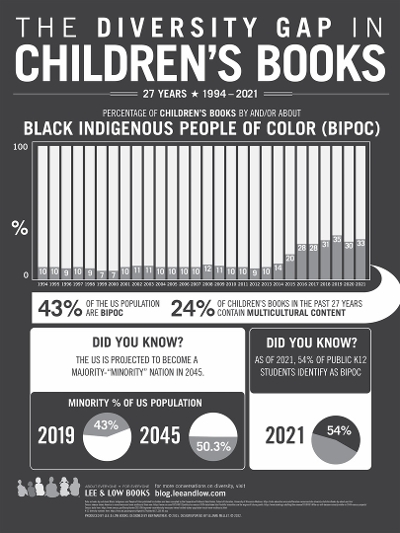A Publisher's Perspective: Three Decades of Inclusive Publishing
In 1991, when Lee & Low Books was founded, the state of diverse books was bleak. Children of color who grew up in the 1990s (or earlier) rarely saw themselves reflected in the pages of a book. Society’s lack of inclusivity led children of color to bend over backward to assimilate (I was one of them). As we tried and failed to erase all evidence of our ancestral backgrounds, all roads would inevitably lead to attracting the notice of white classmates, who often asked, “Where are you from?”
In 1991, when Lee & Low Books was founded, the state of diverse books was bleak. Children of color who grew up in the 1990s (or earlier) rarely saw themselves reflected in the pages of a book. Society’s lack of inclusivity led children of color to bend over backward to assimilate (I was one of them). As we tried and failed to erase all evidence of our ancestral backgrounds, all roads would inevitably lead to attracting the notice of white classmates, who often asked, “Where are you from?”
On the surface the question appears innocuous enough, but to those on the receiving end it was irksome, driving many to self-hatred, as the question implied that we did not belong. Othering as it relates to race continues to this day. Its misuse is immune to and exclusive of how many generations your family has had roots in this country. Othering also disregards the contributions your descendants have made to building this country from the dirt up, all because of the extra amount of melanin in your skin.
Lee & Low Books was based on the principles of publishing books about everyone and for everyone; minority-owned, our mission was to create a publishing program grounded in the work of setting the record straight. We would plug gaps and holes in historical representation, balance the scales by providing books about marginalized people, and tell their stories honestly. So, how has the journey gone so far? Where are we now, and where do we still need to go?

Before anything else, I want to say that we have made progress. But the progress has been slow. Around the time Lee & Low started, the statistics kept by the Cooperative Children’s Book Center (CCBC) calculated that diverse books were just ten percent of books published. Even more astounding was that diverse books remained at ten percent for the next two decades! Why did the quantity of diverse books languish for so long? Part of the reason was systemic bias within the industry, and part was the publishing model itself.
The adage that diverse books do not sell was an unspoken idea shared quietly among booksellers and distributors. This deeply ingrained belief was also a self-fulfilling prophecy: the adequate resources that were known to give a book a fighting chance at success were rarely directed toward diverse books, which resulted in unsurprisingly poor sales. Insufficient marketing dollars did little to get diverse books on the radar of booksellers, who were the de facto sales channel at the time. Booksellers also had the myopic habit of segregating diverse books into their own section, instead of shelving them by theme or genre — a practice that effectively torpedoed any chance of reader discoverability. Massive returns from booksellers ensued, “proving” to the industry that diverse books were a niche market and a fad at best, which was partly why the number of diverse books remained stagnant for decades.
As for Lee & Low, the early years were difficult, and it took many years to break through. We were publishing newbies, and the traditional trade bookseller channels were not working for us. The policy of accepting returns on unsold stock was a practice we had never understood. A back-of-the-napkin calculation revealed that this was an unsustainable way to do business, and many a publisher has found this out the hard way.
Another industry problem that proved vexing was our lack of volume related to building up a formidable backlist. Books, as a product, take years to produce. One main goal of independent diverse publishing is to nurture unpublished, untried BIPOC authors. But, given the limited cash on hand, very modest advances are given, which means that these economies of scale do not allow most people on the creative side to quit their day jobs. How this shakes out is that a book will take two or three times longer to publish because the creators must treat their book work as a side hustle. New authors also require far more time to hone their craft. If the lack-of-volume problem persists, the publisher will never reach the level of equilibrium needed that will allow it to live off its backlist, and its fate will be sealed.
Thankfully, Lee & Low managed to accumulate a strong backlist in a couple of ways.



Over the years, we’ve published more than twelve hundred books, with a concentration on picture-book biographies of notable people of color (such as Shining Star: The Anna May Wong Story, about the first Asian American movie star), balanced with humorous books (such as The Electric Slide and Kai and Zombies Don’t Eat Veggies!).
We’ve also acquired several small presses, including Children’s Book Press, the first multicultural publisher in the U.S., founded in 1975; Shen’s Books; and most recently, Cinco Puntos Press. We choose small presses carefully and favor diversity missions that align with our own. I recently read Isabel Quintero’s Gabi, a Girl in Pieces, one of CPP’s bestsellers. It was fantastic! The voice is funny, honest, and earnest. The book was edited by Lee Byrd, who was Cinco Puntos’s former president. Lee’s business partner and husband, publisher Bobby Byrd, passed away soon after the sale of their thirty-five-year-old company was completed. Half a lifetime dedicated to inclusive publishing is a significant and important contribution to the cause — their legacy will live on with us.
One other notable milestone was our effort to bring diversity and inclusion statistics to the industry with the Diversity Baseline Survey (DBS). We always admired what the CCBC had done with their dataset, and we wanted to contribute in a similar way. In 2015 we released the first iteration of the survey that would become the largest staff diversity survey in the publishing industry. In 2019 we followed up with DBS 2.0, which included the Big Five publishers, small/medium houses, university presses, major review journals, and literary agencies. The survey revealed a distinct lack of diverse hiring across all sectors, with seventy-six percent of the workforce identifying as white. DBS has established itself as the industry’s benchmark and accountability tool for measuring inclusive hiring. The third iteration, DBS 3.0, will be released in January 2024.

Running a small independent publisher has been rewarding and challenging, and it took us more than three decades to fit all the pieces together. We like to say that it took us thirty-plus years to be in the right place at the right time. So, where are we now? The progress I alluded to earlier is that diversity has become a bigger part of the overall zeitgeist of the publishing landscape, with the CCBC reporting that diverse books now exceed thirty percent of all books published in the last four years. Aside from books, representation is noticeably prevalent in popular culture across all mediums. For me, personally, having grown up in a cultural wasteland, to be able to bear witness to the kind of inclusivity that I could only have dreamed about is amazing to experience in my lifetime.
On a more somber note, I want to comment generally on where we as a society still must go, whether we like it or not. At this moment, we are unfortunately a divided people, and the fault lies collectively with us all, because we have let our beliefs calcify. Last year, I visited the National Museum of African American History and Culture (which should be a mandatory visit for all American schoolchildren!) in Washington, DC, for the first time. What the precise curation made clear was that the great majority of developed nations in the 1600s benefited financially from the slave trade. No one was innocent, proof that all histories carry atrocities, and we need to own our transgressions. Humans are mistake machines; we learn by trial and error. We must reestablish an environment that permits everyone the freedom to blunder without fear of being publicly lambasted or made to feel inferior for failing to get it right the first time. Instead, we have created a climate that is fraught with intolerance, silencing and siloing most of us and extinguishing any desire for unity. The empathy deficit will only worsen if people are not allowed to recognize that we are all still works in progress.
From my perspective, publishing represents big ideals, captured in books, a medium that has existed for centuries for a reason. We are the tastemakers. We are the original source on which television and film often graze. While the future isn’t written, the path forward is clear. We must stay the course. We must lead by example by continuing to depict the human condition as widely and inclusively as possible. The publisher’s role is to champion the stories that still need to be told, stories that offer readers a glimpse of the common bonds that we share and the missteps we have made along the way to maintain and fight for our humanity.
From the May/June 2023 special issue of The Horn Book Magazine: Diverse Books: Past, Present, and Future.

RELATED
ALREADY A SUBSCRIBER? LOG IN
We are currently offering this content for free. Sign up now to activate your personal profile, where you can save articles for future viewing.







Add Comment :-
Be the first reader to comment.
Comment Policy:
Comment should not be empty !!!